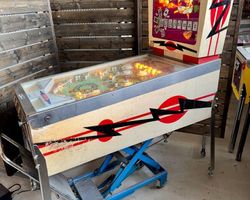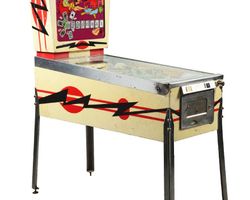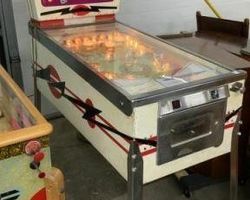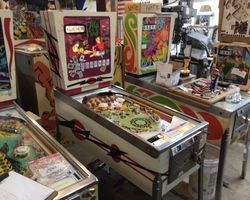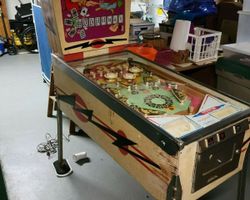Flip-A-Card
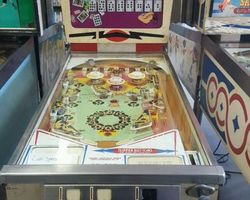
Average Prices: USD $300 to $700
Produced: Febuary, 1970
Production Run: 1,800 units
Machine Type: Electro-mechanical
Players: 1
Design by: Ed Krynski
Art by: Art Stenholm
The pinball machine "Flip-A-Card" from D. Gottlieb & Co. emerged in the Electro-Mechanical (EM) era, a period defined by mechanical ingenuity and vibrant artistic expression on an open playfield. Manufactured in February 1970, with a release date of March 1970, Flip-A-Card joined Gottlieb's diverse catalog as model number 281. The design was conceived by Ed Krynski, a prominent figure in pinball design, while the distinctive visual identity was crafted by Art Stenholm. Gottlieb produced 1,800 units of Flip-A-Card, a respectable run for its time, indicating a solid presence in arcades and amusement locations.
The machine's central theme revolves around playing cards, a subject that offered a familiar and engaging framework for gameplay. However, Art Stenholm's backglass art introduces an unexpected element: a college dorm room complete with pennants and a study desk, subtly blending themes of leisure and student life. This juxtaposition presents an intriguing visual narrative that diverges from a straightforward casino or card game aesthetic. An interesting note regarding the machine's identity is the backglass itself, which displays the title as 'Flip a Card' without hyphens, contrasting with the manufacturer's official 'Flip-A-Card' designation. Furthermore, the production of Flip-A-Card saw a subtle variation in playfield colors, with some units featuring a light beige tint and others a brighter white in specific areas like the "K" rollovers and pop bumper circles, a minor detail that distinguishes subsets of the production run. This machine also has a sibling: Gottlieb's 1970 "Card Trix," an add-a-ball variant of the same core design.
Distinctive Features and Visual Design
Flip-A-Card differentiates itself through several signature elements that collectively shape its character and gameplay experience. A primary standout is its asymmetrical playfield layout. Unlike many contemporary designs that favored a more balanced, mirrored approach, Flip-A-Card embraces an off-kilter arrangement, which inherently encourages diverse shot strategies and adds an element of unpredictability to ball movement. This design choice demands a different kind of precision from players, contributing to the machine’s perceived challenge and replayability.
The backglass, despite some varied opinions on its overall artistic merit, features an engaging light animation where playing cards illuminate, directly tying into the game's central objective. This visual feedback reinforces player progression and creates a dynamic display during gameplay. Within the playfield, the "spin unit" is a prominent mechanical feature. When a ball is skillfully directed into a specific kick-out hole, it activates this unit, which then randomly selects and lights one of the target cards. This element introduces a layer of chance and adds excitement, as players anticipate which card will be awarded, directly influencing their strategy for completing the card set. The machine is equipped with two flippers, three pop bumpers, two slingshots, and seven standup targets, all standard components for the era but strategically placed to interact with the asymmetrical layout. The classic Gottlieb three-chime sound system provides distinct auditory feedback for scoring and objective completion, a characteristic sound that defines many machines from this period.
Playfield Architecture and Mechanical Flow
The playfield of Flip-A-Card is meticulously arranged to foster a challenging and engaging experience, defined by its notable asymmetrical layout. This design philosophy is evident in the placement of key features, which includes a central array of standup targets that represent the playing cards themselves, crucial for advancing game objectives. The three pop bumpers are strategically positioned to create lively ball action, redirecting the ball into unpredictable paths and demanding quick reflexes from the player. Two slingshots at the lower half of the playfield further contribute to the ball's chaotic movement, often sending it back towards the flippers with considerable speed.
A significant element of the playfield is the kick-out hole, which serves as the entry point to activate the unique spin unit. Successfully landing the ball in this hole is a prime objective, as it directly contributes to lighting the card set. The various rollovers, including the distinct "K" rollovers mentioned in the production variations, are integrated into the upper and middle sections of the playfield, offering additional scoring opportunities and influencing ball flow. The artwork on the playfield, while directly supporting the card theme, is functional and clear, ensuring that targets and pathways are easily discernible. However, it is the deliberate, skill-oriented shot geometry that truly defines the playfield's mechanical flow. The layout encourages a variety of challenging shots, rewarding precision and control. This design ensures that players are constantly engaged in managing ball trajectory, making Flip-A-Card a demanding but rewarding machine to navigate. The lighting on the playfield is designed to highlight objectives and provide clear visual cues for scoring, complementing the backglass animation.
Gameplay Dynamics
The core objective in Flip-A-Card centers on lighting all of the playing cards, a progression that drives the entire gameplay experience. Players advance towards this goal by hitting specific standup targets distributed across the asymmetrical playfield and by utilizing the unique spin unit. Successfully navigating the ball into the kick-out hole activates the spin unit, which randomly lights one of the unlit cards, introducing an element of chance to the skill-based shooting. Once all cards are illuminated, the player is rewarded with a "SPECIAL," typically granting a replay, a coveted achievement in EM pinball.
The scoring system is straightforward yet compelling, emphasizing the accumulation of points through various targets and the primary card-lighting objective. The strategic placement of pop bumpers and slingshots means that every shot carries risk and reward. The shorter flippers, characteristic of Gottlieb machines from this era, add a layer of precision requirement to aiming. This makes mastering shots, particularly those to the upper playfield or the elusive kick-out hole, a rewarding challenge. Players often develop strategies around utilizing the machine's geometry, such as executing precise shots to trigger the spin unit or setting up right-hand saving plays to extend ball time. The design intrinsically possesses an addictive quality, leading players to consistently desire "one more game" to perfect their strategy, complete the card set, or achieve a higher score. The combination of clear objectives, challenging shot opportunities, and the thrill of the spin unit makes Flip-A-Card a compelling and engaging pinball experience.
Reception and Enduring Legacy
Flip-A-Card has garnered an overwhelmingly positive reception within the pinball community, consistently described as an enjoyable, challenging, and enduring classic. Its strengths are frequently highlighted, with the gameplay dynamics standing out as a primary draw. Pinball players consistently praise the machine's asymmetrical playfield, noting that this distinctive layout creates a constantly interesting and demanding experience. The variety of shots required to light the cards and manage ball control is often cited as a key factor in its appeal, rewarding skill and precision over mere luck. Many players speak to an "one more game" magnetism, driven by the machine's addictive quality and the clear, achievable objective of lighting all the cards for a special. The integration of the card theme with the gameplay, particularly the unique spin unit that randomly awards cards, is celebrated for adding a distinctive and engaging element that keeps the game fresh. The machine's auditory experience, with its classic Gottlieb chimes, also contributes to its charm, evoking the authentic feel of the EM pinball era. Its perceived value in the market is also often mentioned, with many considering it an undervalued machine given its robust gameplay and historical significance.
However, the machine is not without its areas of critique. The most consistent feedback regarding its weaknesses revolves around the artwork. Many enthusiasts find the backglass art, depicting the college dorm room scene, to be underwhelming, lacking the visual punch often associated with pinball machine backglasses. Similarly, the playfield art is sometimes described as basic or uninspired, particularly in comparison to other machines of the period. Despite these artistic reservations, the overall legacy of Flip-A-Card remains robust. It is considered a strong example of Ed Krynski's design prowess and a definitive EM pinball machine. Its challenging yet rewarding gameplay, combined with its unique features, has cemented its reputation as a machine that continues to engage and satisfy players, often being regarded as one of the best single-player EM games. Its asymmetrical design, while not revolutionary, stands as a testament to the diversity in playfield layouts Gottlieb explored, influencing the perception of what a pinball playfield could be.
Sponsored Links
 Ebay Listings
Ebay Listings
 Auction Results
Auction Results
| Cost | Location | Date |
|---|---|---|
| EUR €1,200 |  Nordrhein-Westfalen, Germany Nordrhein-Westfalen, Germany |
28 June, 2025 |
| USD $2,000 |  Michigan, United States Michigan, United States |
08 February, 2024 |
| USD $751 |  Maryland, United States Maryland, United States |
09 March, 2022 |
| USD $475 |  Illinois, United States Illinois, United States |
02 January, 2021 |
| USD $700 |  New York, United States New York, United States |
27 November, 2020 |
| USD $700 |  Arizona, United States Arizona, United States |
01 June, 2020 |
| GBP £600 |  Edwalton, United Kingdom Edwalton, United Kingdom |
14 July, 2019 |
| USD $514 |  Michigan, United States Michigan, United States |
20 September, 2018 |
| USD $795 |  Michigan, United States Michigan, United States |
09 May, 2018 |
| GBP £505 |  Harrogate, United Kingdom Harrogate, United Kingdom |
24 February, 2018 |


Private Policy · Search Website · Contact Us
As an eBay Partner, we may earn a commission from qualifying purchases made through links on this site, at no additional cost to you.
All trademarks and copyrighted materials remain property of their respective owners. All other content copyright 2007 - 2026 Pinpedia.

